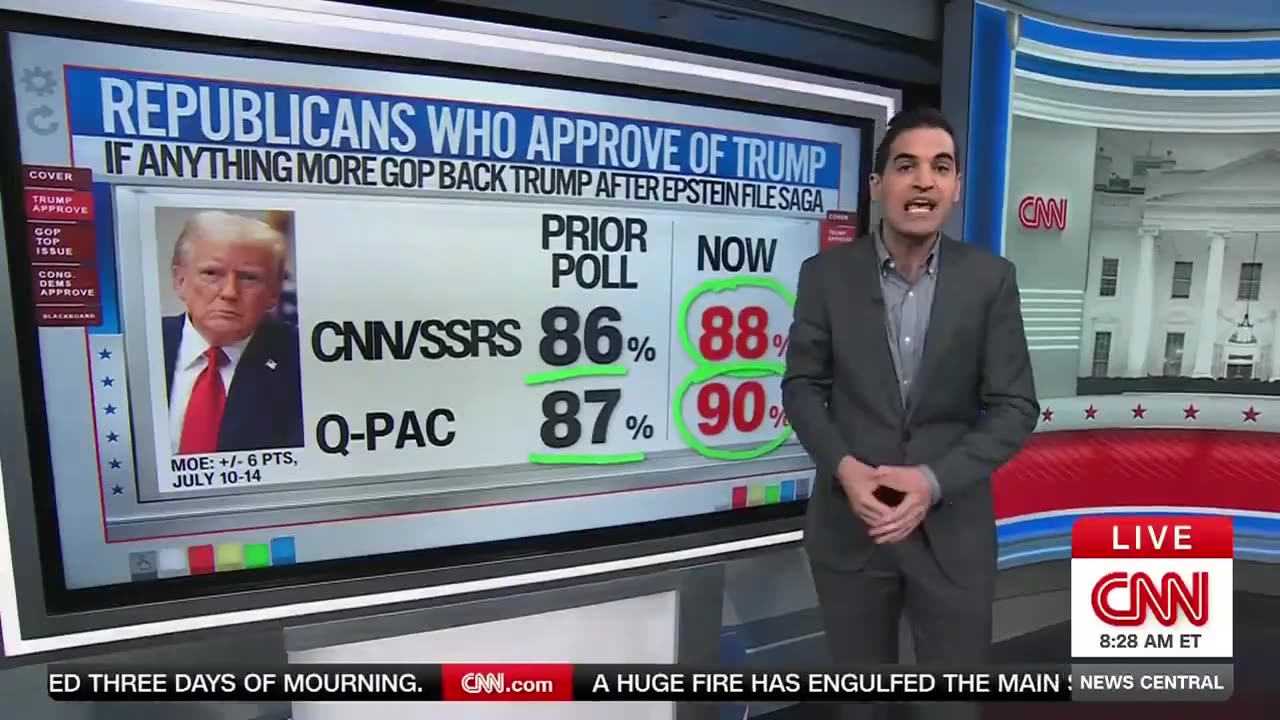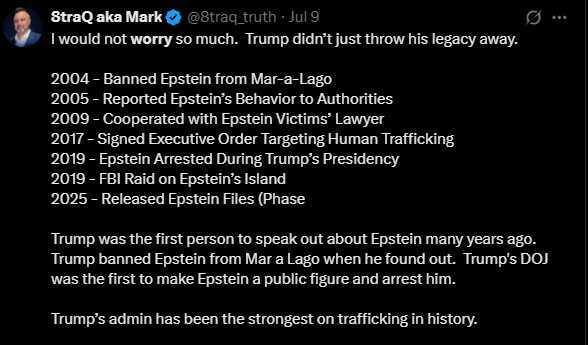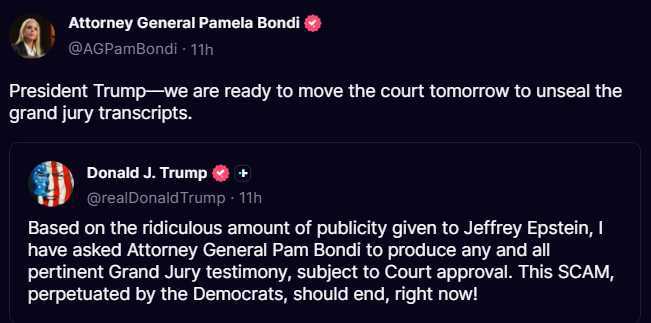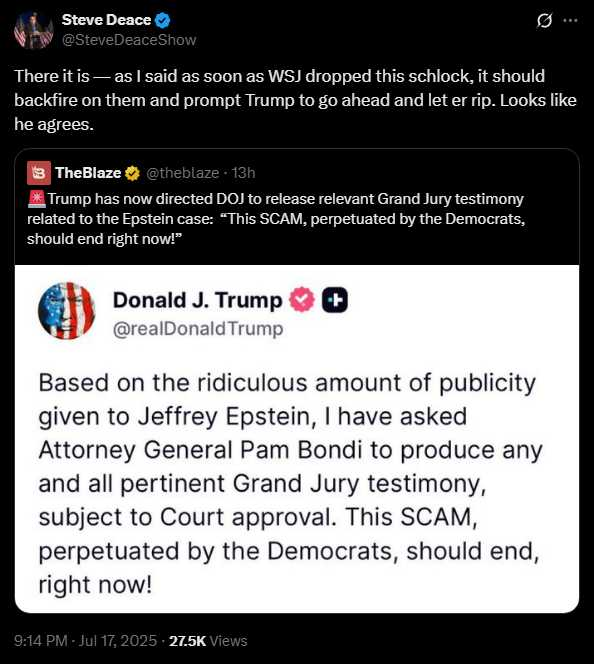“President Trump—we are ready to move the court tomorrow to unseal the grand jury transcripts.” – Attorney General Pamela Bondi
“Based on the ridiculous amount of publicity given to Jeffrey Epstein, I have asked Attorney General Pam Bondi to produce any and all pertinent Grand Jury testimony, subject to Court approval. This SCAM, perpetuated by the Democrats, should end, right now! ” – President Trump
These statements mark the beginning of a pivotal shift not just in the Epstein investigation, but in the broader battle between the MAGA movement and the entrenched political-media complex often referred to as the Deep State.
This is an evolving story, but all signs suggest this move was anything but spontaneous. It looks increasingly like a deliberate, well-timed maneuver aimed at reshaping the national conversation just as the 2025 election cycle gains momentum.
Rather than rush to release evidence during a media storm or while public focus was elsewhere, Trump and his allies waited. They allowed the Left and the press to burn themselves out with partisan stunts. Now, with the public demanding truth and transparency, the Epstein documents are poised to take center stage; their release could change everything.
The Wall Street Journal recently published a story claiming Trump had sent a bizarre letter to Epstein, complete with crude drawings, an accusation Trump flatly denied. In a Truth Social post, he fired back:
"The Wall Street Journal printed a FAKE letter, supposedly to Epstein. These are not my words, not the way I talk. Also, I don’t draw pictures. I told Rupert Murdoch it was a Scam, that he shouldn’t print this Fake Story. But he did, and now I’m going to sue his ass off, and that of his third rate newspaper."
The timing of this (right before the push to unseal grand jury documents) suggests an effort to preemptively smear Trump before the facts come out. But the smear may have backfired, strengthening his legal position and increasing public skepticism toward legacy media.
Now, with momentum on his side, Trump is calling for full transparency, and the political fallout could be massive.
Here are our top reasons why Trump's handing of this, might be his masterstroke.
1. Forces the Media Into a Corner
After wall-to-wall coverage of partisan distractions, the mainstream press is now boxed in. They must either cover the Epstein revelations or expose their own bias by ignoring them. Either outcome benefits MAGA by revealing the truth or revealing the media's complicity.
2. Validates Trump’s Longstanding Actions Against Epstein
Trump banned Epstein from Mar-a-Lago in 2004, reported him in 2005, and led the charge to bring him down during his presidency. The unsealed documents will reinforce Trump’s role as a rare figure in power who took Epstein seriously from the beginning.
3. Exposes Fake MAGA and Grifters
In the lead-up to this release, opportunists posing as “influencers” pushed fake narratives, turned on Trump, or stayed silent. Now their motivations are being exposed. This will further strengthen the authentic MAGA base.
4. Positions Trump as the Leader of Justice and Truth
With the DOJ now moving to unseal the grand jury transcripts at Trump’s request, he appears not only unafraid of scrutiny but demanding transparency. It’s a stark contrast to Democrats who’ve long worked to bury the Epstein story.
5. Reawakens the Demand for Accountability
The American people are starved for justice, especially on matters involving elites and exploitation. The Epstein case hits that nerve. MAGA stands to gain as the only political movement consistently demanding answers.
6. Mobilizes the Base With Fresh Momentum
After years of investigations, indictments, and distractions, the MAGA movement finally gets an offensive win. The unsealing of these files reinvigorates grassroots supporters and draws attention back to the corruption they’ve warned about for years.
7. Discredits the Left’s Weaponization of Government
While Democrats use the DOJ and media to attack political enemies, Trump uses legal means to bring sunlight to dark places. This moment underscores the difference and proves MAGA’s claims of weaponized justice weren't just rhetoric.
8. Potentially Opens the Door to Lawsuits Against Media Outlets
If the documents reveal that media outlets suppressed or misrepresented key facts about Epstein, they could face serious legal exposure. Trump may gain standing to pursue new defamation lawsuits, something he’s already proven effective at. In 2023, Trump won a defamation case against CNN, leading to a quiet settlement where the network paid damages. In another victory, the Washington Post was forced to settle and contribute funds toward Trump’s presidential library after publishing false claims tied to the Russia hoax. These cases show he’s not only willing to fight; he’s capable of winning. If major outlets are caught downplaying or covering up the Epstein network while attacking Trump, more lawsuits could follow and this time, the facts may be even more explosive.
9. Builds the Case for Dismantling the Deep State
The Epstein files won’t just name names, they’ll likely point toward systemic failures (or cover-ups) inside federal agencies. This feeds momentum for deep structural reform which is a key pillar of the MAGA platform.
10. Sparks National Reflection on Suppressed Truths
This moment gives the public a reason to revisit other stories the media buried or twisted. From election integrity to COVID, this opens the floodgates for reexamining the last decade’s biggest lies.
BONUS. Unifies the Movement Across Factions
From grassroots activists to disillusioned independents, the release of these files could be the catalyst that re-energizes the MAGA coalition and draws in new supporters outraged by elite cover-ups. Even CNN was forced to admit that Trump’s poll numbers rose following the Epstein fiasco. This is a clear sign that public sentiment is shifting. As the truth emerges, the movement grows.

In the end...
The unsealing of the Epstein grand jury transcripts isn’t just about exposing one predator. Moreover, it is about revealing the corrupt system that protected him, ignored his victims, and smeared those who sought the truth.
By allowing the media frenzy and partisan noise to peak before acting, Trump may have executed a political masterstroke. What was once mocked as conspiracy theory is now becoming verifiable fact, positioned to dominate the headlines.
If this was his plan all along, it could go down as one of the most strategic plays of his career, not just vindicating his stance, but delivering a decisive blow to the Deep State and rallying the MAGA movement around a renewed call for justice.
Note: This is a developing story but one thing is already clear:
We only know about Epstein's atrocities is because of Trump.
Here’s the timeline:
2004 – Banned Epstein from Mar-a-Lago
2005 – Reported Epstein’s behavior to authorities
2009 – Cooperated with Epstein victims’ lawyer
2017 – Signed Executive Order targeting human trafficking
2019 – Epstein arrested during Trump’s presidency
2019 – FBI raided Epstein’s island
2025 – Epstein files released (Phase One)
2025 – Calls on DOJ to release Phase Two















